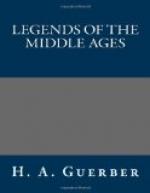This man then revealed to him that Thora, having at her father’s request carefully brought up a dragon from an egg hatched by a swan, had at last seen it assume such colossal proportions that it coiled itself all around the house where she dwelt. Here it watched over her with jealous care, allowing none to approach except the servant who brought the princess her meals and who provided an ox daily for the monster’s sustenance. Jarl Herrand had offered Thora’s hand in marriage, and immense sums of gold, to any hero brave enough to slay this dragon; but none dared venture within reach of its powerful jaws, whence came fire, venom, and noxious vapors.
Ragnar, who as usual thirsted for adventure, immediately made up his mind to go and fight this dragon; and, after donning a peculiar leather and woolen garment, all smeared over with pitch, he attacked and successfully slew the monster.
“’Nor long before
In arms I reached the Gothic shore,
To work the loathly serpent’s death.
I slew the reptile of the heath.’”
Death Song of Regner Lodbrock (Herbert’s tr.).
[Sidenote: Origin of name Lodbrok.] In commemoration of this victory, Ragnar ever after bore also the name of Lodbrok (Leather Hose), although he laid aside this garment as soon as possible, and appeared in royal garb, to receive his prize, the beautiful maiden Thora, whom he had delivered, and whom he now took to be his wife.
“’My prize was Thora; from that fight,
’Mongst warriors am I Lodbrock hight.
I pierced the monster’s scaly side
With steel, the soldier’s wealth and pride.’”
Death Song of Regner Lodbrock (Herbert’s tr.).
Thora gladly accompanied Ragnar back to Hledra, lived happily with him for several years, and bore him two sturdy sons, Agnar and Erik, who soon gave proof of uncommon courage. Such was Ragnar’s devotion to his new wife that he even forbore to take part in the usual viking expeditions, to linger by her side. All his love could not long avail to keep her with him, however, for she soon sickened and died, leaving him an inconsolable widower.
To divert him from his great sorrow, his subjects finally proposed that he should resume his former adventurous career, and prevailed upon him to launch his dragon ship once more and to set sail for foreign shores. Some time during the cruise their bread supply failed, and Ragnar steered his vessel into the port of Spangarhede, where he bade his men carry their flour ashore and ask the people in a hut which he descried there to help them knead and bake their bread. The sailors obeyed; but when they entered the lowly hut and saw the filthy old woman who appeared to be its sole occupant, they hesitated to bespeak her aid.




